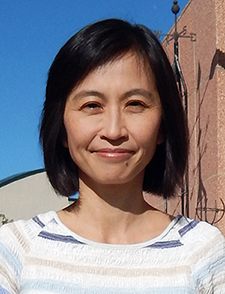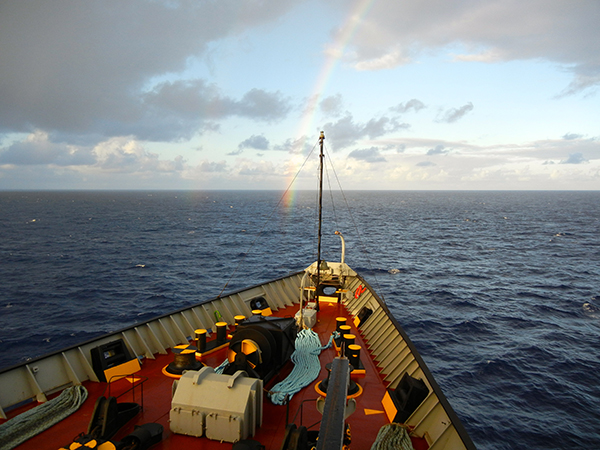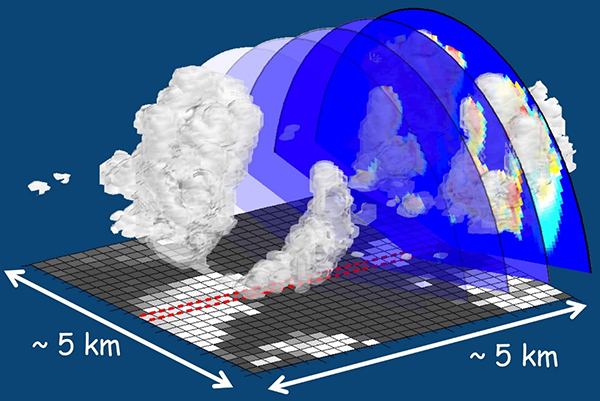UEC Profile: Christine Chiu’s Path to Better Cloud Observations
Published: 18 March 2018
Kindness, Bravery, and Curiosity—Qualities That Have Served Her Well Since Childhood
This is the third article in a series of profiles on members of the ARM User Executive Committee (UEC).

Early in her Taiwan childhood, Christine Chiu realized she was good at math and physics—strengths that led her years later to be the accomplished atmospheric scientist she is today.
Early on, Chiu had courage too. At age 13, still in junior high school, she had a question on chemistry and boldly mailed it to the legendary Wu Ta-You, now known as the “Father of Chinese Physics.” In those days, Wu occupied Taiwan’s highest place in science as president of Academia Sinica, the nation’s central research academy.
He wrote back a 10-page handwritten answer. It shook her with joy.
“You can imagine how I felt,” says Chiu. “He listed several arguments and explained how to solve the question. It was the first time I saw that knowing the answer may not be the most important thing—that the process itself is more fun!”
She adds: “I was just a little girl from a not-so-well-developed town, so his letter really inspired and touched me. I am always grateful for that.”
Chiu never met Wu, who died in 2000. But his letter provided a lesson she embraces to this day. She likes to share with her students a line from Amazon CEO Jeff Bezos: “Cleverness is a gift, kindness is a choice.”
Says Chiu: “I have always respected kind scientists very much.”
That and other lessons followed her from Taiwan’s National Central University to Purdue University in Indiana, where Chiu earned her PhD. From there, she joined the Joint Center for Earth Systems Technology at the University of Maryland, Baltimore County, and at the same time was a researcher at NASA’s Goddard Space Flight Center.
Then it was on to the University of Reading in the United Kingdom, where one draw was being able to mentor students.
As of last fall, Chiu has been an associate professor in the Department of Atmospheric Science at Colorado State University, where her research group investigates remote sensing, radiative transfer, and the interactions of clouds, aerosols, precipitations, and radiation.
“I have been very fortunate,” she says of all her Wu-like colleagues along the way. “People are clever and kind.”
Studying Clouds From All Sides

Chiu investigates clouds, which she calls “complicated 3D objects that evolve fast.”
To know more about them, she studies them from below and on all sides with scanning cloud radars and from above with satellite data.
Cloud properties are the prime determinants of the Earth’s energy budget, and yet they are not represented well in current earth system models. The wide range of earth system predictions, she says, “is a result of inaccurate cloud properties in climate models.”
Chiu sees her present role—in tandem with other scientists—as contributing to a better understanding of the physical processes and radiative effects of clouds and precipitation.
Taking on this role reminds her of a mentor at Goddard, Warren Wiscombe, who told her that “the field is large enough that (you) can find a corner not many people are working in yet.”
For Chiu, that corner is clouds and radiation—for example, developing ground-based cloud retrieval methods using sunphotometer cloud mode observations and lidar background signals. That includes a focus on cloud feedback and on the science of boundary layer clouds. To get at the latter, she synergistically uses measurements from shortwave radiation, scanning cloud radars, and lidars.
“Clouds don’t shout,” says Chiu, who since junior high school has thought of science as “a quiet place for freedom and solitude” in a busy world. “They are just waiting for you to understand them.”
Moving, Doing, Delving

Chiu has moved around the world to practice her science. Bachelor’s degree studies in her native Taiwan gave her the first taste of atmospheric science—an interest that sprang up after she realized she could not be an astronaut, her first science love. “I am severely nearsighted,” she confesses, “and get motion sickness.”
As Chiu was finishing a master’s degree, “I just wanted to do something different than research,” she says, and took a civil service exam to work for Taiwan’s environmental protection agency. She ended up going to graduate school at Purdue, but for environmental engineering at first, not atmospheric science.
“I was afraid,” she says. “At the time, I was not sure I wanted to hang out with atmospheric scientists all the time and talk about meteorology for the rest of my life.”
After a year, the lure of studying clouds drew her back. Her doctoral studies took Chiu deep into satellite observations for precipitation.
Today, she says, “it’s funny that I became the person I was scared of—the one talking about science all the time. But I love it.”
At the same time, Chiu does not forget to see clouds for what they also are: beautiful. “I do enjoy, intellectually, working with observations,” she says. “But I never look at clouds and wonder how many droplets they contain.”
Out in the Field
Often Chiu stands up from her computer and ranges into the field.
She was still at Goddard when she joined the 2005 Marine Stratus Radiation Aerosol and Drizzle (MASRAD) field campaign on the California coast, part of a team studying the microphysical and radiative properties of marine stratus clouds. Her instrument of choice was a 2-channel narrow field-of-view radiometer.
“This radiometer has always been special to me,” says Chiu. “It measures one of the most fundamental cloud radiative properties and shows how, with a small, cheap, and simple instrument, one can do big science too!”
Chiu also has done field research in the Azores. She is a co-investigator for the Aerosol and Cloud Experiments in the Eastern North Atlantic (ACE-ENA) field campaign, a study of low clouds and marine boundary layer aerosols.
Back at her computer in Colorado, she uses data from campaigns that sometimes unfold in dramatic settings far away.
In one case, that data came from eight transects of the Pacific Ocean by a Horizon Lines steam-powered container ship fitted with atmospheric instruments during the Marine ARM GPCI Investigation of Clouds (MAGIC) field campaign of 2012 and 2013.
“I find the intertwined interactions between drizzle, clouds, aerosols, dynamics, and radiation fascinating,” says Chiu.
MAGIC was sponsored by the U.S. Department of Energy’s ARM Climate Research Facility, which maintains fixed and mobile atmospheric observatories and related data repositories that are open to scientists. (Chiu has been an active ARM data user for 15 years.)
To understand the effects of aerosols better, she is involved with the Layered Smoke Interactions with Clouds (LASIC) field campaign sponsored by ARM.
“ARM plays an important role in ground-based observations,” says Chiu, in part by providing data of high temporal and spatial quality that help her “tease out cloud properties and processes.”
From MAGIC came a co-authored paper on a novel method of simultaneously retrieving vertical profiles of both cloud and drizzle. Chiu and others proposed a way around the fact that drizzle often dominates observed radar reflectivity while using active remote sensing on marine boundary layer clouds.
Joining, Editing, Mentoring

Bravery takes many forms. One is taking on the quotidian tasks of scholarship as an editor (Chiu has three such roles), and joining the committees and commissions that advance any field of study.
She is a member of the International Radiation Commission and the ARM Science Board and is chair of the Atmospheric Radiation Committee of the American Meteorological Society.
Chiu is also a member of ARM’s User Executive Committee (UEC), which she says bridges the gap between ARM data users and managers, and which mentors young scientists interested in ARM’s data-rich decades.
The UEC’s explicit mission to bring along young scientists has a connection to Chiu’s own early days.
Her time at Goddard, she says, “really shaped my whole career,” in part because of her mentors, Wiscombe (now retired) and Alexander Marshak.
It was at Goddard too that Chiu first taught and mentored graduate students—an experience so inspiring, so Wu-like in its quality of kindness, that she took an academic job to do more of it.
At the University of Reading in the U.K., she worked with an outstanding cloud remote sensing group. Now Colorado State offers what she calls “fantastic new opportunities” to mentor more students and “to start exciting projects with my new colleagues—no doubt heavily involving ARM data.”
Says Chiu: “Every place I go influences my science.”
The ARM Climate Research Facility is a DOE Office of Science user facility. The ARM Facility is operated by nine DOE national laboratories.
Keep up with the Atmospheric Observer
Updates on ARM news, events, and opportunities delivered to your inbox
ARM User Profile
ARM welcomes users from all institutions and nations. A free ARM user account is needed to access ARM data.


















